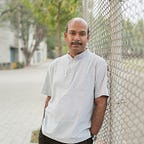The Mystical Chair — A Profound Symbolism in the Atharvaveda
ऋचः प्राञ्चस्तन्तवः यजुंषि तिर्यञ्चः
ṛcaḥ prāñcastantavaḥ yajuṃṣi tiryañcaḥ
This Mantra from Atharvaveda 15.3.6 speaks of the two threads of a chair: the straight one called the diirghatantu (दीर्घतन्तु) or taanam (तानम्) or simply tantu (तन्तु), and the cross-thread called vakragaamitantu (वक्रगामि तन्तु) or vaanam (वानम्) or otu (ओतु). In order to understand the intent of the above Mantra of Rishi Pippalada it is necessary to see the whole context in which it is placed.
It thus happened that once the Supreme Lord, the Master of all remained confined to His highest abode. Other gods were unable to find out his whereabouts and could not have any interaction with Him. They all gathered in prayer and addressed him saying: ‘O Lord, O Master of all, where are you?” A subtle voice was heard — “if you all make arrangements for a befitting chair for me I will settle on it and you all can have my presence all the time.” Hearing this the gods immediately started the process of making the desired chair for their Master. They made the four prominent seasons — summer (griishma — ग्रीष्म), spring (vasanta — वसन्त ), autumn (sharad — शरत्), and rainy (varshaa — वर्षा), as the four legs of the chair. The frame of the elbow-piece of the seat was made by two saama (साम) chants known as brihat (बृहत्) and rathantara (रथान्तर ). The frame of the cross-board was made by another two saama chants called yajnaayajniya (यज्ञायज्ञीय) and vaamadevya (वामदेव्य). The Mantras of the Rigveda were used as the main thread called taanam (तानम्) and the the Mantras of Yajurveda were used as the cross-thread called vaanam. All knowledge became the coverlet of the seat. The knowledge of Brahman became the pillows. The contemplative saama (साम) became the foot-stool and the sound OM became its armrests.
The Mantra is a highly symbolic one indicating that when everything necessary for the Divine to be present is lacking one will never feel the presence of the Divine. One needs therefore to create and keep the physical, emotional, psychological and spiritual conditions suitable for the Divine presence to remain intact. The four seasons becoming the four legs refers to the fact that whatever conditions we create to keep the Divine presence intact those conditions must remain steady in all seasons meaning in all situations of life. The four different saama chants — brihat (बृहत्) & rathantra (रथान्तर ), yajnayajniya (यज्ञायज्ञीय) & vaamadevya (वामदेव्य)— used as the two sets of the frames of the chair symbolise the four important chants of Saama which have the power to evoke devotion to the Lord and create the atmosphere for the the Divine presence to work. The word brihat (बृहत्) signifies that if we wish to make our heart the seat for the Divine then we must live in the expanded consciousness, our heart must be udaara (उदार) or magnanimous. The word rathaantara (रथान्तर) signifies that we must make proper use of our body (ratha or the chariot) to fulfil the ultimate aim of our life. The word yajnaayajniiya (यज्ञायज्ञीय) means that every work of ours must become an offering to the Master of work. The word vaamadevya (वामदेव्य) implies that we must develop within us all that is noble, divine, beautiful and perfect. The Mantras of Rigveda being used as taanam or the main thread signifies that the source of all knowledge and all sciences must become our main engagement. The Mantras of Yajurveda being used as the vaanam or the cross-thread signifies that our deeds must be as per the principal threads of the truth as expressed through the Mantras of Rigveda. Once the chair was made then it was decorated with coverlets and cushions and armrests and footstool. The entire treasure of knowledge became the coverlet which was spread on the sitting portion. The knowledge of Brahman became the pillows. The contemplative saamaveda became the footstool and the OM (chanted in the beginning and at the end of a Mantra) became the armrests. Ing After decorating the chair the gods called the Master to sit on it and then all others became busy serving the Master and doing what He wished. This indeed is the truth of life that one has to grow more and more aware of the Divine will and work as per it keeping the Master at the center and following all that He wills.
[PS: More than the symbolism in this Mantra what is fascinating is the whole story of making a chair and decorating it. The keywords used here threads, pillows, and coverlets give a clear indication of the world of handloom and textiles in ancient India.]
